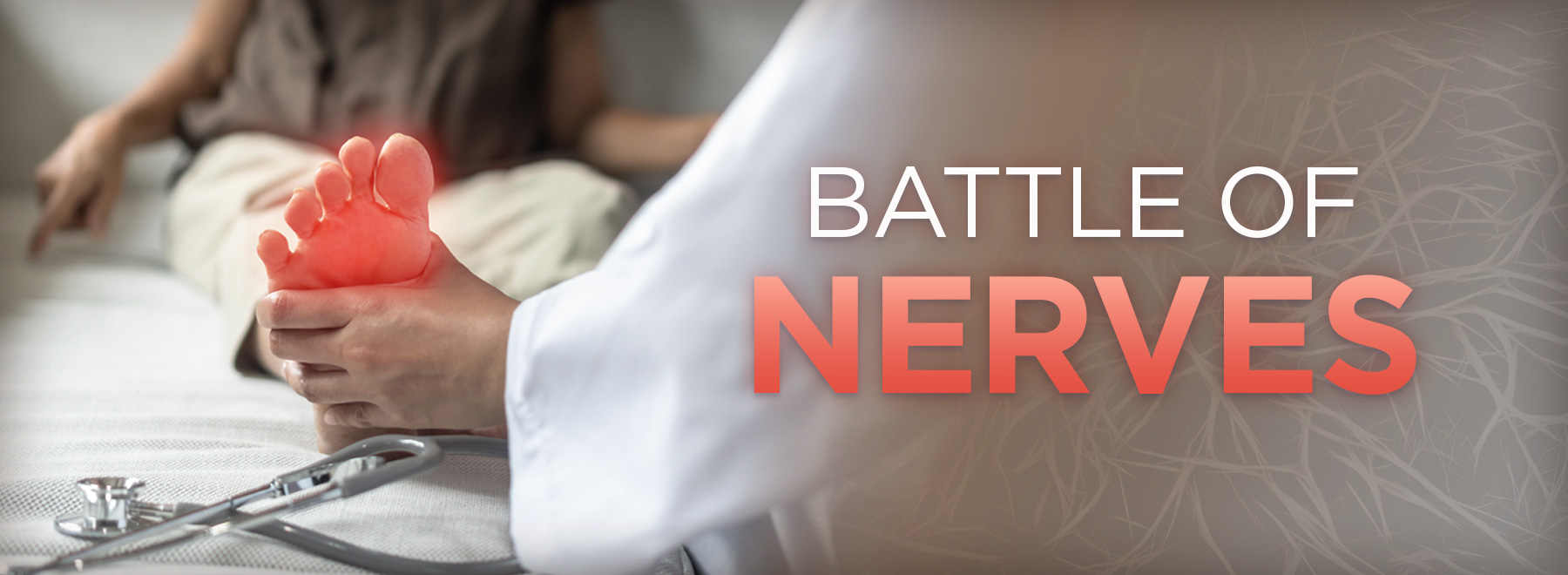Peripheral neuropathy’s discomforts run the gamut – from numbness to pain
It feels like walking on pillows.
Or like your feet have been dipped in concrete.

“One person said it was like they had their hands in a glove full of sand – they always felt gritty,” said Dr. Amanda Witt.
Witt, professor of neurology at the University of Mississippi Medical Center, has heard these descriptions from patients afflicted by peripheral neuropathy – a series of conditions shaking up part of the nervous system.

Witt, along with Dr. Ike Eriator, is one of several UMMC experts who are familiar with the causes, symptoms, treatment and prevention of this common disorder.
“It affects millions of people in the U.S.,” said Eriator, professor of anesthesiology.
“It is a non-specific term that generally refers to any nerve disorder that affects the peripheral part of the nervous system – distinct from the brain and the spinal cord.
“It can arise from many causes, including diseases like diabetes, which is the most common cause; medications, including those used for chemotherapy; nerve compression; infections; vitamin deficiencies; environmental exposures like lead poisoning.” It can even be an inherited condition.
Symptoms – including weakness, numbness, tingling and pain – usually disturb the hands and feet. But these sensations can occur anywhere if the small nerve fibers are affected, said Witt.
When large nerve fibers are the target, numbness and tingling start in the toes and feet, rising gradually to the knees – and that’s when the fingers will also start to go numb, Witt said. Feet and hands can become weak, disrupting balance.
“Our inner ear and our vision must compensate, which makes it difficult for persons with neuropathy to negotiate safely in a darkened room or with their eyes closed,” she said.
Another type of neuropathy, autonomic, damages nerves that control the internal organs. It can result in heat intolerance, heart palpitations or a racing heart rate when standing. “Blood pressure can drop when the person stands,” Witt said. Other potential conditions: nausea, constipation and lack of bowel and bladder control.
Peripheral neuropathy is more common with age, especially for people in their 70s and 80s. “As we grow older, we are more likely to develop other medical conditions, like diabetes – a big risk factor,” Eriator said.
“Our peripheral nerves change with age, increasing our predisposition to neuropathy. It’s harder to absorb certain vitamins, such as B12, which is necessary for the brain and nervous system to function normally.”
At least 50% of neuropathies are secondary to diabetes, either type 1 or type 2, and this risk increases with the length of time a person has diabetes, Witt said.
“Even pre-diabetes or early insulin resistance can cause a neuropathy years before a formal diagnosis of diabetes is made.”
Another common risk factor: drinking alcohol. “Unfortunately, it’s not known how much alcohol use it will take to cause a neuropathy in any given person – sometimes even a glass of wine a day is enough to cause a neuropathy over years,” Witt said. “This risk would increase with age as well.”
Peripheral neuropathy may also plague people with certain illnesses, such as rheumatoid arthritis, some blood cancers, lupus and Sjogren’s disease, which attacks the immune system.
But a large number of people have idiopathic neuropathy. “Meaning we cannot find a direct cause,” Witt said.
Because peripheral neuropathy has many possible origins, Eriator said, “it makes sense that different medical specialties see, investigate and manage the condition.
“It is in the domain of general neurology and, often, neurologists see the patients, work them up, and ascertain a possible cause. But anesthesiologists who are pain specialists can also be involved – pain can be a distressing feature as the disorder runs its course.”
For her part, Witt can interpret tests that show how the nerves are working, or not working.
“In the exam room, we can test reflexes, sensation to light touch, pinprick and vibration,” she said. “We also evaluate for gait and balance.
“An electrodiagnostic study with nerve conduction can evaluate for severity and can diagnose a large fiber neuropathy. There are autonomic function tests for small fiber neuropathy and autonomic neuropathies.
“Once a neuropathy is diagnosed, then we do lab work to try to find a cause.”
Treatment options include:
- Immunosuppressants – drugs that weaken the body’s immune response – for autoimmune neuropathy
- Vitamins, if there is a vitamin deficiency
“However, for most neuropathies, we can only treat the symptoms and work to prevent complications such as falls,” Witt said. “We recommend no loose rugs around the home, night lights for safety in the dark, and use of appropriate equipment such as a hiking pole or cane to help with balance.
“If the neuropathy is painful, then we use nerve pain medications. But we are unable to treat the numbness or lack of sensation.”
There are a few ways to stop it from ever occurring, Witt said.
Eating a balanced diet, exercising, maintaining a healthy weight and not smoking are ways to prevent that major neuropathy jump starter, diabetes.
If you take medications, ask your doctor if they could be the culprits, including certain antidepressants and antiseizure drugs.
“HIV and hepatitis C can cause neuropathies,” Witt said, “so, avoiding IV drug use and unsafe sex practices can prevent those related neuropathies.
“And monitor alcohol use, being especially careful to avoid daily intake or binge drinking.”
— — —
Find more information about neurosciences care and services or appointments at UMMC here.
The above article appears in CONSULT, UMMC’s monthly e-newsletter sharing news about cutting-edge clinical and health science education advances and innovative biomedical research at the Medical Center and giving you tips and suggestions on how you and the people you love can live a healthier life. Click here and enter your email address to receive CONSULT free of charge. You may cancel at any time.



